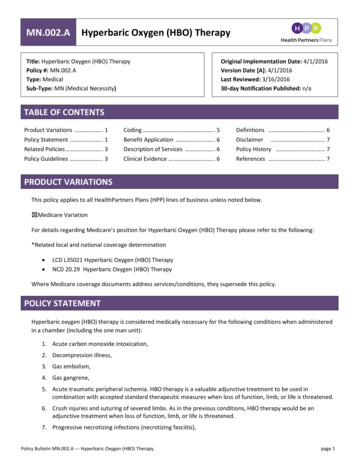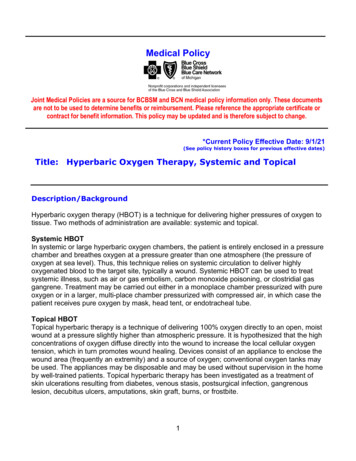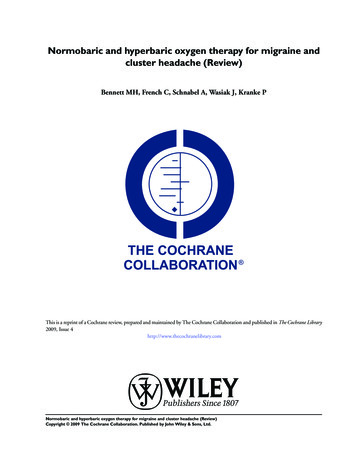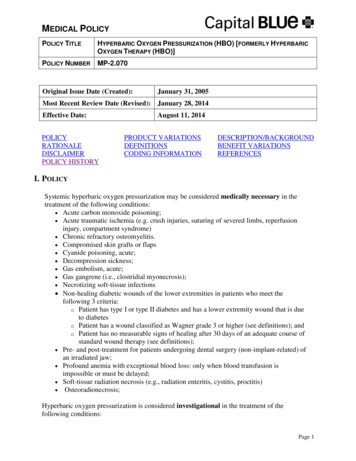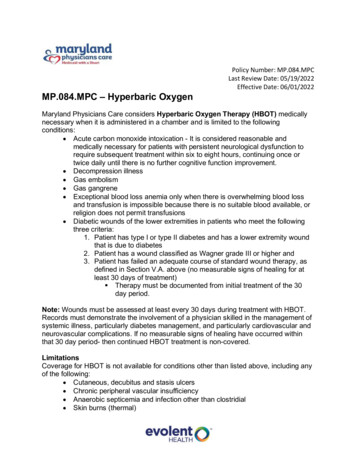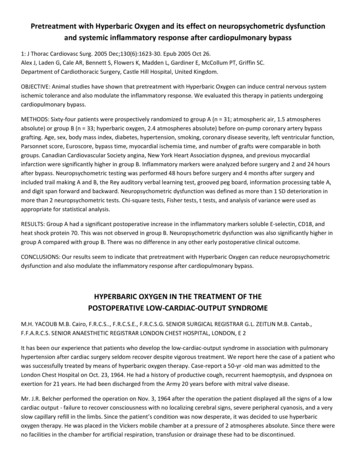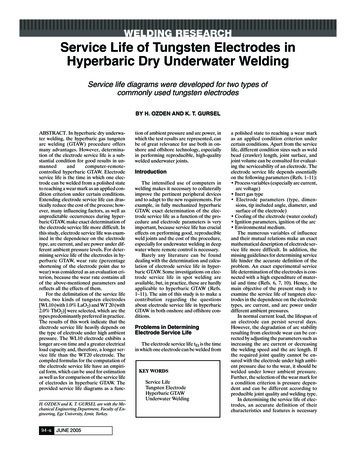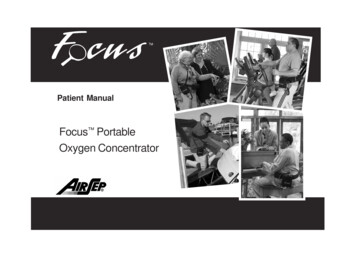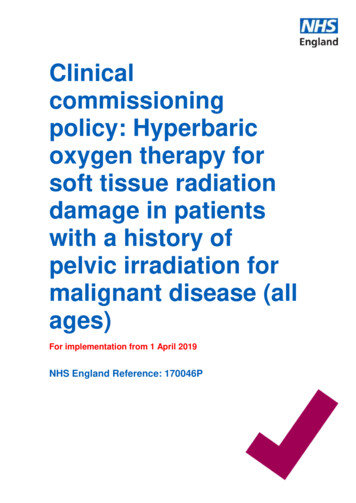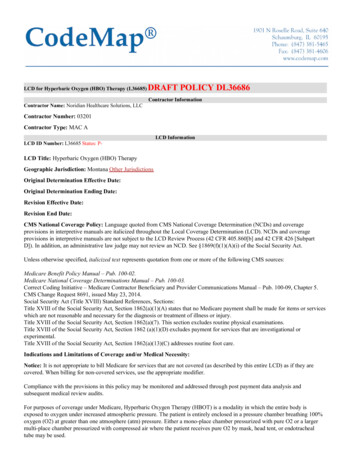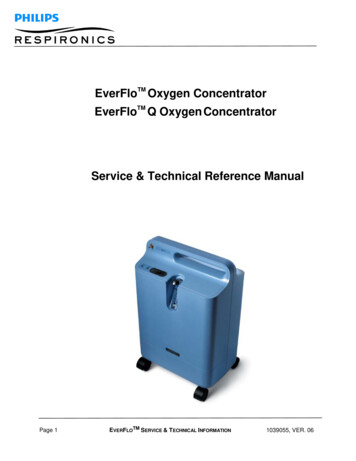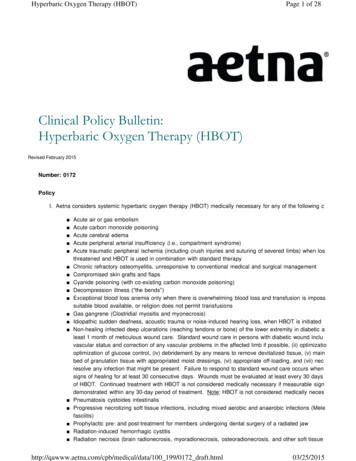
Transcription
Hyperbaric Oxygen Therapy (HBOT)Page 1 of 28Clinical Policy Bulletin:Hyperbaric Oxygen Therapy (HBOT)Revised February 2015Number: 0172PolicyI. Aetna considers systemic hyperbaric oxygen therapy (HBOT) medically necessary for any of the following c Acute air or gas embolismAcute carbon monoxide poisoningAcute cerebral edemaAcute peripheral arterial insufficiency (i.e., compartment syndrome)Acute traumatic peripheral ischemia (including crush injuries and suturing of severed limbs) when losthreatened and HBOT is used in combination with standard therapyChronic refractory osteomyelitis, unresponsive to conventional medical and surgical managementCompromised skin grafts and flapsCyanide poisoning (with co-existing carbon monoxide poisoning)Decompression illness (“the bends”)Exceptional blood loss anemia only when there is overwhelming blood loss and transfusion is imposssuitable blood available, or religion does not permit transfusionsGas gangrene (Clostridial myositis and myonecrosis)Idiopathic sudden deafness, acoustic trauma or noise-induced hearing loss, when HBOT is initiatedNon-healing infected deep ulcerations (reaching tendons or bone) of the lower extremity in diabetic aleast 1 month of meticulous wound care. Standard wound care in persons with diabetic wound incluvascular status and correction of any vascular problems in the affected limb if possible, (ii) optimizatiooptimization of glucose control, (iv) debridement by any means to remove devitalized tissue, (v) mainbed of granulation tissue with appropriated moist dressings, (vi) appropriate off-loading, and (vii) necresolve any infection that might be present. Failure to respond to standard wound care occurs whensigns of healing for at least 30 consecutive days. Wounds must be evaluated at least every 30 daysof HBOT. Continued treatment with HBOT is not considered medically necessary if measurable signdemonstrated within any 30-day period of treatment. Note: HBOT is not considered medically necesPneumatosis cystoides intestinalisProgressive necrotizing soft tissue infections, including mixed aerobic and anaerobic infections (Melefasciitis)Prophylactic pre- and post-treatment for members undergoing dental surgery of a radiated jawRadiation-induced hemorrhagic cystitisRadiation necrosis (brain radionecrosis, myoradionecrosis, osteoradionecrosis, and other soft tissuehttp://qawww.aetna.com/cpb/medical/data/100 199/0172 draft.html03/25/2015
Hyperbaric Oxygen Therapy (HBOT)Page 2 of 28 Radiation proctitisII. Aetna considers the use of systemic HBOT experimental and investigational for the following conditions (nobecause there is insufficient evidence in the medical literature establishing that systemic HBOT is more effetherapies: Actinic skin damageActinomycosis and other mycosesAcute coronary syndromeAcute or chronic cerebrovascular insufficiency/accident (including thrombotic or embolic stroke)Acute renal arterial insufficiencyAcute thermal and chemical pulmonary damage, i.e., smoke inhalation (e.g., carbon tetrachloride, hypulmonary insufficiencyAerobic septicemia and systemic aerobic infectionAnaerobic septicemia and infection other than clostridialAnoxic brain injuryArthritic diseasesArthritisAseptic necrosis of the femoral head and neckAutismBell's palsyBone grafts or fracture healing (e.g., nonunion fractures)Calciphylaxis (calcific uremic arteriolopathy)CancerCardiogenic shockCerebral palsyChronic peripheral vascular insufficiencyClosed head and/or spinal cord injuryCognitive impairment (e.g., senility, senile dementia) Cystic acneDiabetic foot ulcers that are not infectedDiabetic superficial woundsFacial neuritisFibromyalgiaFrostbiteGlioblastomaHepatic artery thrombosisHepatic necrosisHIV infectionInfective polyneuritisInflammatory bowel disease (Crohn’s disease and ulcerative colitis)Interstitial cystitisIntra-abdominal abscess, pseudomembranous colitis (antibiotic-induced colitis)Intracranial abscessesIschemia due to lupus vasculitisLegg-Calve Perthes diseaseLepromatous leprosyLyme l/data/100 199/0172 draft.html03/25/2015
Hyperbaric Oxygen Therapy (HBOT) Page 3 of 28MelasmaMeningitisMethicillin-resistant Staphylococcus aureus (MRSA) infectionsMigraine or cluster headachesMultiple sclerosisMyocardial infarctionMyofascial pain syndromeNecrotizing arachnidismNon-compromised skin grafts and flapsNon-diabetic cutaneous, decubitus, pressure and venous stasis ulcersNon-vascular causes of chronic brain syndrome (e.g., Alzheimer's disease, Korsakoff's disease, PickOphthalmologic diseases (including central retinal artery occlusion, central retinal vein occlusion, diaglaucoma, keratoendotheliosis, radiation injury to the optic nerve, retinal detachment)Organ transplantation and storageOsteonecrosis of the jawOsteoporosisOtitis externaParkinson's diseasePost-organ transplantation re-vascularizationPulmonary emphysemaPyoderma gangrenosumRadiation-induced cholangitis, myelitis, enteritis, sarcomaRaynaud’s syndromeRecto-vaginal fistulaReflex sympathetic dystrophy (complex regional pain syndrome)Seizure disordersSickle cell crisis or hematuriaSkin burns (thermal)Superficial and/or non-infected diabetic ulcersSurgical wound dehiscenceSystemic inflammatory response syndromeTetanusTinnitusTraumatic brain injuryVesicocutaneous fistulaXerostomia/salivary gland dysfunctionIII. Aetna considers systemic HBOT experimental and investigational for members with any of the following conHBOT, as the safety of systemic HBOT for persons with these contraindications to HBOT has not been esta Concurrent administration of doxorubicin, cisplatin, or disulfiram Premature infants (birth prior to 37 weeks gestation) Untreated pneumothoraxIV. Aetna considers topical HBOT directly administered to the open wound, and limb-specific hyperbaric oxygenlimb-encasing devices experimental and investigational because its efficacy has not been established a/100 199/0172 draft.html03/25/2015
Hyperbaric Oxygen Therapy (HBOT)Page 4 of 28BackgroundHyperbaric oxygen therapy (HBOT) is defined as systemic treatment in which the entire patient is placed inside a pbreathes 100 % oxygen under a pressure greater than 1 atmosphere (atm). It is used to treat certain diseases andimprove when an increased partial pressure of oxygen is present in perfused tissues.The literature states that HBOT should not be a replacement for other standard successful therapeutic measures.response of the individual patient and the severity of the original problem, treatment may range from less than 1 weduration, the average being 2 to 4 weeks. Hyperbaric oxygen therapy for more than 2 months is usually not necesHyperbaric oxygen therapy has been shown to be an effective method for treating diabetic foot wounds in carefullyextremity lesions. Although the results of multiple retrospective studies involving a significant number of patients ha high success rate in patients who had been refractory to other modes of therapy, several recent prospective, randsupported the adjunctive role of systemic hyperbaric oxygen therapy in the treatment of non-healing infected deeppatients with diabetes. Such evidence is lacking, however, for superficial diabetic wounds and non-diabetic cutanevenous stasis ulcers.A number of technology assessment organizations, including the Cochrane Collaboration, the Wessex Institute, theFoundation for Medical Research, and the Agency for Healthcare Research and Quality (AHRQ), have systematicsupporting the use of hyperbaric oxygen for each of the indications for which it has been used.An evidence review conducted by the Alberta Heritage Foundation for Medical Research (Hailey, 2003) concludedsupported for a number of conditions, including non-diabetic wounds, multiple sclerosis, cerebral palsy, decubitus uarachnidism, actinomycosis, cardiovascular conditions, Bell's palsy, cluster and migraine headaches, Legg-Calvedisease, osteoporosis, cancer, head trauma, cognitive impairment, senile dementia, glaucoma, keratoendotheliosisneuritis, and nonunion of fractures.A systematic evidence review conducted for the Agency for Healthcare Research and Quality (AHRQ) (McDonaghinsufficient evidence to support the use of HBOT in brain injury. The assessment concluded that "The balance of bHBOT for brain injury, cerebral palsy, or stroke has not been adequately studied."Denton et al (2004) systematically reviewed the evidence regarding HBOT for radiation cystitis. Of the 19 studies tall the reports were case series and only 1 was a prospective series. The authors stated that "[t]he level of evidenrepresent is essentially IIIC (weak evidence), apart from one prospective case series of forty patients." The latter swas graded IIC (prospective study without calculation of sample size and without accurate and standard definitionIn a Cochrane review, Bennett et al (2005) concluded that for people with acute coronary syndrome, individual smaaddition of HBOT reduced the risk of major adverse cardiac events, some dysrrhythmias, and reduced the time tobut did not reduce mortality. They noted that in view of the modest number of patients, methodological shortcominresult should be interpreted cautiously, and an appropriately powered trial of high methodological rigor is justified tany) who can be expected to derive most benefit from HBOT. The routine application of HBOT to these patients careview.A Cochrane review (Bennett et al, 2005) assessed the evidence of effectiveness of HBOT for long-term radiation irectum. The investigators found HBOT significantly improved chance of healing for radiation proctitis (relative riskinterval [CI]: 1.2 to 6.0). The investigators concluded that small trials suggest that HBOT is useful for treatment ofto the anus and rectum.Absolute contraindications to HBOT include: untreated pneumothorax, concurrent administration of disulfuram (Antadministration of the antineoplastic agents doxorubicin and cisplatinum; and administration to premature infants (dhttp://qawww.aetna.com/cpb/medical/data/100 199/0172 draft.html03/25/2015
Hyperbaric Oxygen Therapy (HBOT)Page 5 of 28fibroplasia). Relative contraindications to the use of HBOT include prior chest surgery, lung disease, viral infectionsurgery, optic neuritis, seizure disorders, high fever, congenital spherocytosis, and claustrophobia.Topical HBOT administered to the open wound in small limb-encasing devices is not systemic HBOT and its efficacestablished due to the lack of controlled clinical trials. In addition, in vitro evidence suggests that topical HBOT dooxygen tension beyond the superficial dermis. Examples of topical HBOT devices are TOPOX portable hyperbaricsacral chambers (Jersey City, NJ), Oxyboot and Oxyhealer from GWR Medical, L.L.P. (Chadds Ford, PA).The Undersea and Hyperbaric Medical Society issued the following policy statement on topical oxygen, often referhyperbaric oxygen therapy” (Feldmeier et al, 2005): “1. Topical oxygen should not be termed hyperbaric oxygen sinintentionally or unintentionally suggests that topical oxygen treatment is equivalent or even identical to hyperbaricdocuments reporting experience with topical oxygen should clearly state that topical oxygen not hyperbaric oxygenMechanisms of action or clinical study results for hyperbaric oxygen can not and should not be co-opted to supporthyperbaric oxygen therapy and topical oxygen have different routes and probably efficiencies of entry into the wounand biochemistry are necessarily different. 3. The application of topical oxygen cannot be recommended outside obased on the volume and quality of scientific supporting evidence available, nor does the Society recommend thirdreimbursement. 4. Before topical oxygen can be recommended as therapy for non-healing wounds, its applicationsame intense scientific scrutiny to which systemic hyperbaric oxygen has been held”.There is insufficient evidence of the effectiveness of hyperbaric oxygen as a treatment for autism. Rossignol (2007neurodevelopmental disorder currently affecting as many as 1 out of 166 children in the United States. Numerousindividuals have revealed evidence of cerebral hypoperfusion, neuro-inflammation and gastrointestinal inflammatiooxidative stress, relative mitochondrial dysfunction, neurotransmitter abnormalities, impaired detoxification of toxinsproduction of porphyrins. Many of these findings have been correlated with core autistic symptoms. For example,autistic children has been correlated with repetitive, self-stimulatory and stereotypical behaviors, and impairments iperception, and social interaction. Hyperbaric oxygen therapy might be able to improve each of these problems inSpecifically HBOT has been used with clinical success in several cerebral hypoperfusion conditions and can compblood flow by increasing the oxygen content of plasma and body tissues. Hyperbaric oxygen therapy has been repanti-inflammatory properties and has been shown to improve immune function. There is evidence that oxidative stHBOT through the upregulation of antioxidant enzymes. Hyperbaric oxygen therapy can also increase the functionmitochondria and improve neurotransmitter abnormalities. In addition, HBOT up-regulates enzymes that can helpproblems specifically found in autistic children. Dysbiosis is common in autistic children and HBOT can improve thporphyrins in autistic children might affect the production of heme, and HBOT might help overcome the effects of thhas been shown to mobilize stem cells from the bone marrow to the systemic circulation. Recent studies in humancells can enter the brain and form new neurons, astrocytes, and microglia. It is expected that amelioration of thesepathophysiological problems through the use of HBOT will lead to improvements in autistic symptoms. Several stuin autistic children are currently underway and early results are promising.An systematic evidence review of hyperbaric oxygen therapy for autism (Moqadem and Pineau, 2007) prepared fotechnology assessment agency, concluded: "In light of its assessment, AETMIS concludes that there is insuffi ciencase for the efficacy of hyperbaric oxygen therapy in the management of autistic disorders. In these circumstancesbe conducted to evaluate the results of the current and future studies. In short, for the management of autism, hypshould, for now, be considered an experimental treatment modality. Consequently, this treatment should be limitedprojects."Rossignol et al (2009) carried out a multi-center, randomized, double-blind, controlled study to evaluate the effectivwith autism. A total of 62 children with autism recruited from 6 centers, aged 2 to 7 years (mean of 4.92 /- 1.21) w40 hourly treatments of either HBOT at 1.3 atm and 24 % oxygen ("treatment group", n 33) or slightly pressurize21 % oxygen ("control group", n 29). Outcome measures included Clinical Global Impression (CGI) scale, Aberra(ABC), and Autism Treatment Evaluation Checklist (ATEC). After 40 sessions, mean physician CGI scores significtreatment group compared to controls in overall functioning (p 0.0008), receptive language (p 0.0001), social ineye contact (p 0.0102); 9/30 children (30 %) in the treatment group were rated as "very much improved" or "muchttp://qawww.aetna.com/cpb/medical/data/100 199/0172 draft.html03/25/2015
Hyperbaric Oxygen Therapy (HBOT)Page 6 of 282/26 (8 %) of controls (p 0.0471); 24/30 (80 %) in the treatment group improved compared to 10/26 (38 %) of conparental CGI scores significantly improved in the treatment group compared to controls in overall functioning (p 0language (p 0.0168), and eye contact (p 0.0322). On the ABC, significant improvements were observed in thescore, irritability, stereotypy, hyperactivity, and speech (p 0.03 for each), but not in the control group. In the treatthe control group, mean changes on the ABC total score and subscales were similar except a greater number of chirritability (p 0.0311). On the ATEC, sensory/cognitive awareness significantly improved (p 0.0367) in the treatthe control group. Post-hoc analysis indicated that children over age 5 and children with lower initial autism severitimprovements. Hyperbaric treatment was safe and well-tolerated. The authors reported that children with autismatm and 24 % oxygen for 40 hourly sessions had significant improvements in overall functioning, receptive languagcontact, and sensory/cognitive awareness compared to children who received slightly pressurized room air.Rossignol et al (2009) concluded that "[g]iven the positive findings of this study, and the shortage of proven treatmautism, parents who pursue hyperbaric treatment for their child with autism can be assured that it is a safe treatmeused in this study (1.3 atm), and that it may improve certain autistic behaviors. Further studies are needed by othethese findings; we are aware of several other planned or ongoing studies of hyperbaric treatment in children with athe positive results of this study and those of several previous studies, the use of hyperbaric treatment appears to bfor children with autism".The study by Rossignol et al (2009) had several major limitations. First, there were no significant differences betwcontrol groups for most of the primary outcomes. In the treatment group compared to the control group, mean chascore and subscales were similar except a greater number of children improved in irritability (p 0.0311). There wdifferences between treatment and control groups in total ABC score, and in the subscales for social withdrawal, stand speech. Furthermore, analysis of changes in ATEC total score and subscale scores between the treatment ansignificant differences between treatment and controls only in the sensory/cognitive awareness subscale. There wdifferences between treatment and control groups in total score, and in the subscales for speech, sociability, and hmean physician CGI scores significantly improved in the treatment group compared to controls in overall functioninsocial interaction, and eye contact; there were no significant differences between treatment and control groups in texpressive language, sleep pattern, attention span, activity level, bowel movement pattern, self-stimulatory behavioawareness/alertness, play skills, self-injurious behavior, mood, anxiety level, aggression, general health, gross moskills. Also, while mean parental CGI scores significantly improved in the treatment group compared to controls inreceptive language, and eye contact; there were no significant differences in the treatment group compared to contlanguage, sleep pattern, attention span, activity level, bowel movement pattern, self-stimulatory behavior, social awinteraction, play skills, self-injurious behavior, mood, anxiety level, aggression, general health, gross motor skills, aMoreover, while post-hoc analysis was able to identify subgroups of subjects who demonstrated additional statisticdifferences, these findings would need to be confirmed by a prospective study of these subgroups.Another important issue that was not fully addressed was the adequacy of blinding. The study states that 6 adultsdistinguish between the treatment and control situation. But the usual method of testing the adequacy of blinding is(children and parents) and investigators themselves to ascertain if they are able to distinguish between treatment awould be expected by chance, which was not done in this study. The important issue is whether or not the personsin the study were able to distinguish between treatment and control better than would be expected by chance, andsignificance are employed in this analysis.The most critical issue that was not addressed in this study was the durability of results. These investigators measinitiation and immediately upon completion of 40 HBOT sessions. However, the treatment and control groups weresubstantial period of time after the study was completed to determine whether significant differences between treatpersisted. In other words, does HBOT result in durable benefits, or do any improvements dissipate after completioIt should also be noted that autism is not approved as an indication for HBOT neither by the Undersea and Hyperbthe European Committee for Hyperbaric Medicine (Yildiz et al, 2008). Furthermore, in a review on autism, Levy anthat popular biologically based treatments include anti-infectives, chelation medications, gastrointestinal medicationimmunoglobulins. Non-biologically based treatments include auditory integration therapy, chiropractic therapy, crahttp://qawww.aetna.com/cpb/medical/data/100 199/0172 draft.html03/25/2015
Hyperbaric Oxygen Therapy (HBOT)Page 7 of 28interactive metronome, and transcranial stimulation. However, few studies have addressed the safety and effectivetreatments.Ghanizadeh (2012) stated that there is a controversy regarding the effectiveness of HBOT for the treatment of autisystematically reviewed the current evidences for treating of autism with HBOT. According to PRISMA guidelines fthe databases of MEDLINE/PubMed, Google Scholar, and Randomized Controlled Trials in Hyperbaric Medicine wsearched. In addition, medical subject heading terms and text words for hyperbaric oxygen therapy and autism weinclusion criteria were published studies that reported the original data from the trials conducted on the patients witoutcomes with a valid and reliable instrument. A quality assessment was also conducted. The electronically searcpublications. Two studies were randomized, double-blind, controlled-clinical trials. While some uncontrolled and csuggested that HBOT is effective for the treatment of autism, these promising effects are not replicated. The authocontrolled studies with rigorous methodology are needed to provide scientific evidence-based HBOT for autism treAlthough a recent article (Butler et al, 2008) included ischemic central retinal vein and artery occlusions among indno reliable evidence that supports the effectiveness of this treatment for these indications.Folio et al (2007) described a case of frostbite to all fingers of a mountain climber, treated with HBOT. All fingers efunction, with only some cosmetic deformity to the tip of the most severely affected finger. Because few cases of fhave been reported, these researchers hoped that such case reports will stimulate future research in this area. It isanecdotal cases may help guide future research in this area. Sequential digital photographs were taken at variousHBOT. They raised the possibility of photographic techniques and standards that may facilitate planning of therapyimproved treatment comparisons, resulting in more consistency in the future. For example, a graphical software athat allows morphing of sequential images to demonstrate healing progress in a concise movie format. The morphdemonstration of healing to the referring provider and patient and helps in teaching and research on frostbite treatmKiralp et al (2009) evaluated the effects of HBOT on myofascial pain syndrome (MPS). A total of 30 patients with tdivided into HBOT (n 20) and control groups (n 10). Patients in the HBOT group received a total of 10 HBOT sPatients in the control group received placebo treatment in a hyperbaric chamber. Pain threshold and visual analomeasurements were performed immediately before and after HBOT and 3 months thereafter. Additionally, Pain DiShort Form 12 Health Survey (SF-12) evaluations were done before HBOT and after 3 months. Hyperbaric oxygentolerated with no complications. In the HBOT group, pain threshold significantly increased and VAS scores significimmediately after and 3 months after HBOT. Furthermore, PDI, Mental and Physical Health SF-12 scores improveafter 3 months compared with pre-treatment values. In the control group, pain thresholds, VAS score, and Mentalnot change with placebo treatment; however, significant improvement was observed in the Physical Health SF-12 tconcluded that HBOT may be a valuable alternative to other methods in the management of MPS. They stated thfurther randomized, double-blinded and placebo-controlled studies to evaluate the possible role of HBOT in the maUrade (2009) stated that bisphosphonates (BPs) are effective in the treatment of hypercalcemia of malignancy, muevents associated with metastatic breast cancer and prostate cancer, and osteoporosis. Despite these benefits, hoBP-related osteonecrosis of the jaws (BRONJ) becomes a growing and significant problem in a subset of patientsespecially intravenous preparations. Bisphosphonate-related osteonecrosis of the jaws has also been reported in tBPs, although the incidence is extremely low. Most of BRONJ cases occur after dental treatments such as tooth esurgery, and dental implants, and are refractory to conventional treatment modalities such as debridement, antibiotcompared to EU and USA, the number of BRONJ case is still small in Japan, but it is exactly increasing year by yenumber of BRONJ in patients receiving oral BPs to that in patients receiving intravenous BPs is higher in Japan thaspeculating due to the difference of time of approval. In this communication, the practical guidelines for preventionof BRONJ recently released from USA and Canada were introduced. Although no effective therapy for BRONJ hasimportance of oral hygiene, patient education and treatments suitable for clinical stage was emphasized.Freiberger (2009) stated that BPs suppress bone turnover by disrupting osteoclast signal transduction, maturation,patients, it has been hypothesized that suppressed turnover can impair oral wound healing, leading to BRONJ. Hyas an adjunct to surgery and antibiotics, might have utility in the treatment of BRONJ because it produces 0 199/0172 draft.html03/25/2015
Hyperbaric Oxygen Therapy (HBOT)Page 8 of 28species that positively modulate the redox-sensitive intracellular signaling molecules involved in bone turnover. Thin the treatment of BRONJ is currently under investigation in randomized controlled trials (RCTs) at Duke UniversitMinnesota, and the early results have been encouraging. This report discussed osteoclast biology, how HBOT habone turnover by way of the signaling effects on osteoclasts, the available clinical data on HBOT in the treatment oRCTs of HBOT, and the study-associated efforts to find biomarkers to characterize an individual's risk of developinVescovi and Nammour (2010) stated that BRONJ is an area of uncovered bone in the maxillo-facial region that didafter identification by health care provider, in a patient who was receiving or had been exposed to BP therapy (BPTradiation therapy to the craniofacial region. Low-grade risk of ONJ is connected with oral BPT used in the treatmeosteoporosis and Paget's disease (from 0.01 % to 0.04 %) while higher-grade risk is associated with intravenous (Itreatment of multiple myeloma and bone metastases (from 0.8 % to 12 %). The management of BRONJ currentlytreatment has yet been developed and interrupting BPT does not seem to be beneficial. Temporary suspension ofbenefit, while long-term discontinuation (if systemic conditions permit it) may be beneficial in stabilizing sites of ONsymptoms. The use of oral anti-microbial rinses in combination with oral systemic antibiotic therapy -- penicillin, mclindamycin, doxycycline, erythromycin -- is indicated for stages I and II of Ruggiero's staging. The role of HBOT isbenefits of this treatment have recently been described in association with discontinuation of BPT and conventionasurgical).In a Cochrane review, Eskes and colleagues (2010) examined the effects of HBOT as a treatment for acute woundsurgery and trauma). Randomized controlled trials comparing HBOT with other interventions or comparisons betwregimens were selected. Two review authors conducted selection of trials, risk of bias assessment, data extractionindependently. Any disagreements were referred to a third review author. A total fo 3 trials involving 219 subjectsstudies were clinically heterogeneous, therefore a meta-analysis was inappropriate. One trial (48 participants withsplit skin grafts) compared HBOT with usual care and reported a significantly higher complete graft survival associhealthy graft area risk ratio [RR] 3.50; 95 % CI: 1.35 to 9.11). A second trial (36 participants with crush injuries) repwounds healed with HBOT than with sham HBOT (RR 1.70; 95 % CI: 1.11 to 2.61) and fewer additional surgical prHBOT: RR 0.25; 95 % CI: 0.06 to 1.02 and significantly less tissue necrosis: RR 0.13; 95 % CI: 0.02 to 0.90). A thundergoing flap grafting) reported no significant differences in complete graft survival with HBOT compared with de95 % CI: 0.95 to 1.38) or heparin (RR 1.21; 95 % CI: 0.99 to 1.49). Many of the pre-defined secondary outcomesmortality, pain scores, quality of life, patient satisfaction, activities daily living, increase in transcutaneous oxygen pamputation, length of hospital stay and costs, were not reported. All 3 trials were at unclear or high risk of bias. Tthere is a lack of high quality, valid research evidence regarding the effects of HBOT on wound healing. While 2 smHBOT may improve the outcomes of skin grafting and trauma, these trials were at risk of bias. They stated that furof high quality RCTs is needed.The Canadian Agency for Drugs and Technologies in Health's review on the use of HBOT for difficult wound (Boud7 health technology assessments, 5 systematic reviews, and 1 RCT. Overall, the authors of the identified studies fclinically effective as well as cost-effective when it was used to treat patients with diabetes who have lower extremiwas some positive evidence to suggest that HBOT was clinically effective when it was used to treat radiation proctiwas considered insufficient to promote the routine use of H
The Undersea and Hyperbaric Medical Society issued the following policy statement on topical oxygen, often refer hyperbaric oxygen therapy" (Feldmeier et al, 2005): "1. Topical oxygen should not be termed hyperbaric oxygen sin intentionally or unintentionally suggests that topical oxygen treatment is equivalent or even identical to hyperbaric
